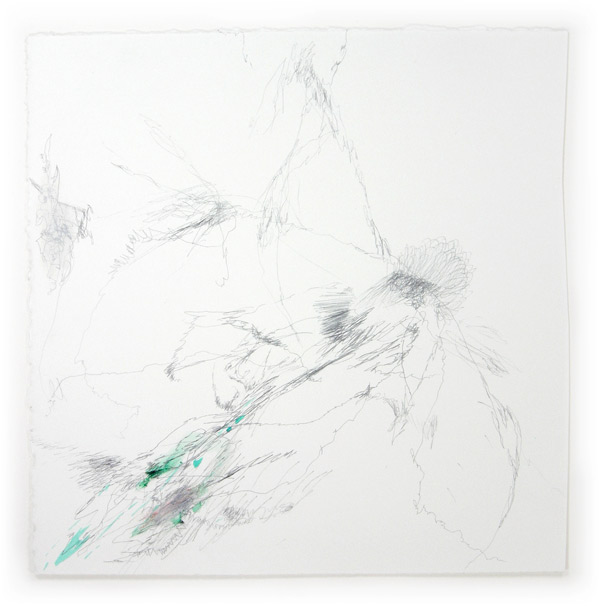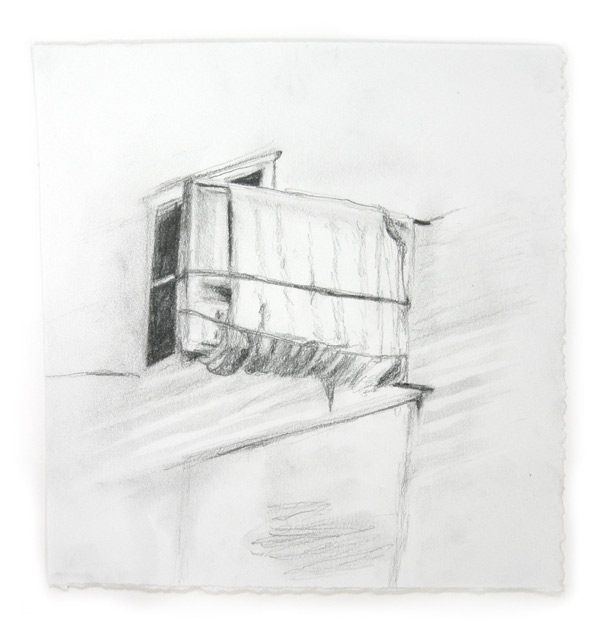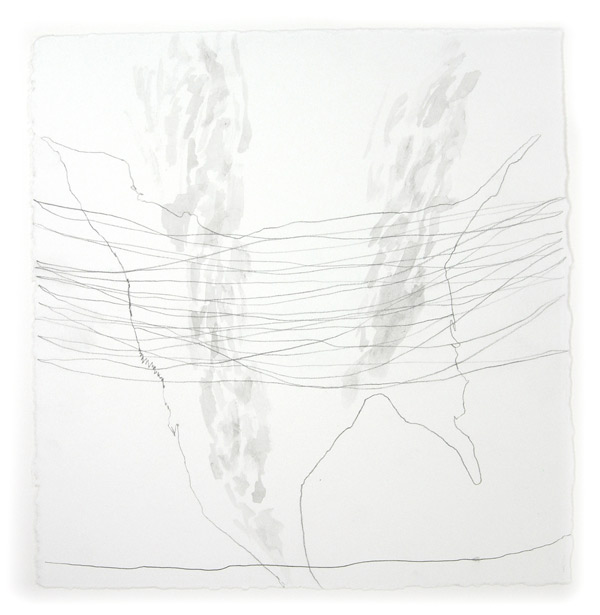Archive for September, 2007
“I began building on a piece of land” Release
OAKLAND, CA: September 11th, 2007 – The Present Group, a quarterly art subscription service, unveiled an interactive online version of artist Christine Kesler’s “I began building on a piece of land†today. Kesler’s series of 65 drawings is part landscape painting, part collage. The surfaces of some pieces are heavily built up from found bits of paper and debris, while others are delicately rendered in pencil and thin washes. Each describes a specific topography that Kesler encountered on her recent drive across the United States to her new home in San Francisco.
As critic Anuradha Vikram writes, “The result of her labors is a series of psychogeographical maps. Colorful scraps bearing handwriting from a thousand strangers, their most intimate moments momentarily recorded and then tossed aside, are worked into graceful drawings on paper, worked with pen, pencil, india ink, watercolor, gesso and pastelâ€
The 65 pieces, which were commissioned on behalf of The Present Group’s subscribers, are now available for the public to explore online, along with Kesler’s audio commentary describing her journey, an interview, formal critique, annotated links to other resources, and a discussion of the work.
When: Now
Where: www.thepresentgroup.com
A New Way of Supporting Contemporary Art: Subscription Art
The Present Group is like a mutual fund that produces art instead of profits. As a private grant-giving organization, it enables a community of subscribers to support contemporary artists and receive original artwork in return. With The Present Group everyone benefits. Artists gain a new avenue of support. Subscribers receive exclusive and compelling works of art. The world gets an accessible resource and welcoming meeting place devoted to contemporary art.
Contact: co-founder, Oliver Wise, oliver@thepresentgroup.com, 510.419.0616
TPG3 – Discussion
Please use this space to contribute your thoughts and impressions of “I began building on a piece of landâ€
You are also welcome to start a discussion relating to the work in any way.
TPG3 – Annotated Links
Art and Travel
The Art of Travel – Alain de Botton’s The Art of Travel is not a guide to travelling but an exploration of the role of travel, broadly understood, in the lives and work of some eminent artists and writers. He writes “the most effective means of pursuing this conscious understanding [of beauty] was by attempting to describe beautiful places through art, by writing about or drawing them, irrespective of whether one happened to have any talent for doing so.”Mostly focuses on 19th century artists. Buy from Amazon The book was also made into a Television series
Non-Places of Travel in Visual Art – art created with “non-places” as a site for work especially when dealing with themes of lost identity/travel/anonynimity. ” These artists choose them as subjects because, despite their initial bleakness, these non-places have something to say to us. Although a non-place, a lack of place, may signify a loss of identity, it simultaneously creates its own unique experience of new and previously unexpected identities.” by Edita Marelic
Space is the Place – an exhibit in scottsdale, Az that gathers together artists interested in the ulitmate frontier: space travel
 Franz Ackermann – “His work frequently deals with the double side of tourism- the glamour, speed and consumption of international travel but also the detritus, architectural scarring and garbage that it leaves behind, and his installations often take on the appearance of strange advertisements for a global tourism industry run amok.”
Franz Ackermann – “His work frequently deals with the double side of tourism- the glamour, speed and consumption of international travel but also the detritus, architectural scarring and garbage that it leaves behind, and his installations often take on the appearance of strange advertisements for a global tourism industry run amok.”
Angela Bulloch- a review of this Young British Artist’s show where she played a videotape, shot first from inside an airplane then from inside a car, recording the entire journey made by the artist to arrive at the gallery.
William Kentridge - William Kentridge uses drawing as a means for story-telling, often dealing with city life, and propelled by his conscience. He is “interested in…an art of ambiguity, contradiction, uncompleted gestures and uncertain endings.”
.
Christine’s Links:
Christine’s photos from the trip.
The Drawing Center in New York City continues to be one of the foremost institutions in the world to promote experimentation and innovation in the medium of drawing.
On The Road Twelve years ago, this book saw the birth of my wanderlust. Kerouac blessed me with his visions of “the raw body of America itself.”

Nicola Lopez A New York artist who confronts the chaos of urban/human-built landscape, travel and mobility, and information over-saturation. Her experiential mapping resonates with my own work.
An essay on William Least Heat Moon’s novel that led me right up to this trip.
Gordon Matta Clark was a seminal multi-media artist who confronted his own mortality in making enormous marks in the landscape and cityscape around him. Specifically, in cutting open warehouses left abandoned by the city of New York and empty suburban homes; in graceful drawings and photographs that brought to light a bleak reality of the socio-economic scene in America’s 1970s; and in performances- his training and his point of departure was architecture, but his use of materials elevated, reduced, and transformed the very concept of “building.”
.
.
.
.
Introduction to Collecting Works on Paper
Collecting works on paper is a great entry into collecting fine art, especially in the past decade. Collecting works on paper has become very desirable because pieces by emerging artists can be acquired at low price points and there is a lot of innovative work being done in the medium. Collectors are attracted to the uniqueness of works on paper, as opposed to prints, and to the experimental nature, exploration and story-telling through the intimacy of paper.
Works of art on paper include drawings (in any media), collages and other paper-based methods, but not prints (prints are made by drawing a stone or metal surface, not on paper or canvas, from which an image is printed a number of times).
Works on paper are delicate and can be easily damaged, so proper care is a must. When unframed, works on paper must be handled using cotton gloves to protect the paper’s ph-balance from the natural oils in your skin. Poor framing and exposure to strong light are also issues. The paper should be framed using acid-free materials because the acid from regular paper or cardboard will eat into the paper and stain it. You can choose between museum-quality, UV retardant glass or Plexiglas to reduce fading. Cleaning agents should never be used on the glass or Plexiglas because it removes the UV protection and the paper should never be in direct contact with glass; use a spacer. Once framed, a work on paper should not be hung in very humid areas which will cause fungus to grow, this is known as foxing (small brown spots). Also environments that are too dry or cold will cause the paper to become brittle and crack and dust and pollution are also variables that can damage all works of art.
In regards to lighting, if at all possible one should avoid halogen and florescent lights and use tungsten light instead. Works on paper should never be rolled in tubes for mailing or rolled for extended periods of storage. They should be stored flat, between acid-free tissue paper or glassine.
If properly taken care of, works on paper should retain their value and can potentially increase the integrity and synchronicity of a collection overall.
Lauren Gentile, Assistant Director and Director of Sales at Irvine Contemporary is a 2007 graduate of the Sotheby’s Institute in London. She specializes in the economics in the international art market, with expertise in valuation, art advisory services and art collection management. Ms. Gentile holds a Master’s in Art Business degree from SIA London, where she wrote her thesis on fine art as an alternative asset class and fine art investing; the work focused on the recent phenomena of fine art funds. She also has a thorough background in art history, and holds two B.A. degrees in art history and international studies from DePaul University in Chicago. She has studied art history, Italian and German at The School of the Art Institute in Chicago, the Goethe Institute, and the University of Florence.
Building Between Worlds by Anuradha Vikram
contemporary art criticism TPG3
Christine Kesler’s series of drawings is part landscape painting, part collage. The surfaces of some pieces are heavily built up from found bits of paper and debris, while others are delicately rendered in pencil and thin washes. Each describes a specific topography that Kesler encountered on her recent drive across the United States. Her meandering journey from Brooklyn to San Francisco included tours through the backroads of West Virginia, South Dakota and Utah.
 The result of her labors is a series of psychogeographical maps. Colorful scraps bearing handwriting from a thousand strangers, their most intimate moments momentarily recorded and then tossed aside, are worked into graceful drawings on paper, worked with pen, pencil, india ink, watercolor, gesso and pastel. Kesler collects and saves these cast-off pieces from everywhere she goes, combining particulate matter from sites present and past with handwriting and drawing of her own. She observes natural terrain with an architect’s eye, focusing on the uneasy relationship between humans and their environment. The fine pencil lines that run through the frame could be interstate highways or horizon lines, running endlessly through time. The faint outlines of rivers and mountains she draws form an abstracted timeline of separation, change, and renewal.
The result of her labors is a series of psychogeographical maps. Colorful scraps bearing handwriting from a thousand strangers, their most intimate moments momentarily recorded and then tossed aside, are worked into graceful drawings on paper, worked with pen, pencil, india ink, watercolor, gesso and pastel. Kesler collects and saves these cast-off pieces from everywhere she goes, combining particulate matter from sites present and past with handwriting and drawing of her own. She observes natural terrain with an architect’s eye, focusing on the uneasy relationship between humans and their environment. The fine pencil lines that run through the frame could be interstate highways or horizon lines, running endlessly through time. The faint outlines of rivers and mountains she draws form an abstracted timeline of separation, change, and renewal.
The daily practice of drawing became an endurance test for Kesler, demanding discipline and a degree of compulsion. She worked in the car and in motel rooms – the confined spaces that frame the open road. There is claustrophobia evident in the crumpled paper that pushes against the edges of several drawings, and in the rapidly converging perspective of many others. There is also expansiveness, as in the open lines that radiate from a peaceful blue center of water in one drawing. The regular size and shape of each work in the group highlights the tension between these moments.
It is important to understand that these 65 drawings, though distributed individually, are elements of a larger work. Each individual image is a complete portrait of a moment and a place, and as a collection they act as a personal history of transition and discovery. Ownership of one of these works is membership in a community, which begins with the unknown collaborators whose leavings Kesler appropriates and regifts to the owners of her work. She is the conduit for a material connection between two groups of people unknown to one another or to her.
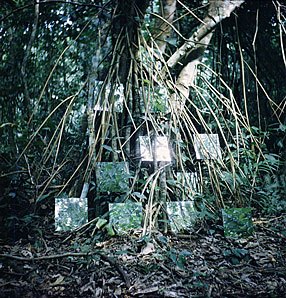 Some precedents exist for Kesler’s collapsing of fragments of time, places, and physical material onto a single plane, yet in her work, these devices are used for narrative and poetic ends. Robert Smithson’s Yucatan Mirror Displacements (1969), in which he used mirrors to disrupt the spatial and temporal landscape of a site, posited the image as both a reflection of the space and time we inhabit, and a permeable barrier collapsing here and elsewhere. This is a concept which Kesler transfers back onto the page, by presenting the remnants of her journeys in a manner that similarly flattens four dimensions. Her take on this is a narrative one, but abstractly so, presenting countless fragments of stories. She has touched down in many places, collecting histories but leaving no mark of her own.
Some precedents exist for Kesler’s collapsing of fragments of time, places, and physical material onto a single plane, yet in her work, these devices are used for narrative and poetic ends. Robert Smithson’s Yucatan Mirror Displacements (1969), in which he used mirrors to disrupt the spatial and temporal landscape of a site, posited the image as both a reflection of the space and time we inhabit, and a permeable barrier collapsing here and elsewhere. This is a concept which Kesler transfers back onto the page, by presenting the remnants of her journeys in a manner that similarly flattens four dimensions. Her take on this is a narrative one, but abstractly so, presenting countless fragments of stories. She has touched down in many places, collecting histories but leaving no mark of her own.
Kesler’s act of collecting the detritus of lives as she travels recalls a documentary tradition in photography, a medium in which she also works. She references Robert Frank’s The Americans as an inspiration, recognizing that seminal book for its geographic range and its penetrating look at all levels of society. Yet Kesler’s work is not documentary, but rather poetry of a visual kind, and as such it also draws on the legacy of the Beat writers’ poetic travelogues. She herself is a poet, and the sparcity of language in her texts is reflective of the spare hand she brings to her art.
This series began its life cycle as an installation, created in a warehouse in Prospect Heights, Brooklyn, which the artist dismantled and recycled into the work we see today. Her exploration is tempered by the anxiety of homelessness. As she took apart and packaged up her life for the move, so she did the same with her art, reflecting a personal experience that resonates with so many individuals who have similarly abandoned one home to establish another. This sense of displacement is at the emotional core of the work; being without a place in the world can be liberating and terrifying. This pervasive feeling of uncertainty deepens her perspective beyond that of a tourist, into that of a modern-day landless settler in search of a new world.
Her impermanence – indeed, her mortality, her humanity – is at the essence of these artworks. Despite our best efforts as a species, that impermanence haunts us all. Perhaps by participating in communities such as the one Kesler weaves, we can each leave our mark.
.
.
.
.
Anuradha Vikram, a curator and writer based in San Francisco’s East Bay, is Program Director at Headlands Center for the Arts in Sausalito, California, where she curates public programs, studio work-in-progress and temporary exhibitions, and supervises the residency and commissions programs. In the summer of 2006, she was Associate Producer of the ISEA2006 Symposium and concurrent Zero One San Jose: A Global Festival of Art on the Edge, August 7-13, 2006, in San Jose, CA, where she co-curated C4F3: The Café for the Interactive City at the San Jose Museum of Art and produced 50 installations and performances by international artists. Prior to the festival, Anuradha was Exhibitions Director at the Richmond Art Center from 2005-2006, where she curated the group exhibition Dress: Clothing as Art and solo exhibitions by Ala Ebtekar, Mads Lynnerup and Beth Cook, and organized numerous others. Anuradha was awarded an M.A. in Curatorial Practice from California College of the Arts, San Francisco, in 2005, and holds a B.S. in Studio Art from New York University, completed 1997.
Anuradha is currently Programs Co-Chair for Northern California ArtTable, and a Curatorial Advisor for Pro Arts, Oakland, CA. She served on the jury for the San Francisco Foundation Murphy and Cadogan Fellowships in June 2006. Anuradha was studio and collections manager for sculptors Claes Oldenburg and Coosje van Bruggen from 1998-2002; project manager for commissions for San Francisco glass artist Nikolas Weinstein from 2002-2004; and an intern in the Department of Painting and Sculpture at the San Francisco Museum of Modern Art in 2004. Recent independent projects include Beyond Explanation: Automatic Abstraction, a group exhibition at the National Institute for Art and Disabilities (NIAD), Richmond, CA, September 5-October 13, 2006; Winter Dreams, Transmissions Gallery, Berkeley, CA, November 1-December 23, 2006; and several reviews published in online and print publications.
Interview with Christine Kesler
artist interviews Artist Interviews others lives TPG3
Christine Kesler was interviewed in Oakland, CA on August 24, 2007
by Oliver Wise and Eleanor Hanson Wise of The Present Group.
Listen: (20:25)
Introduction to “I began building on a piece of land”
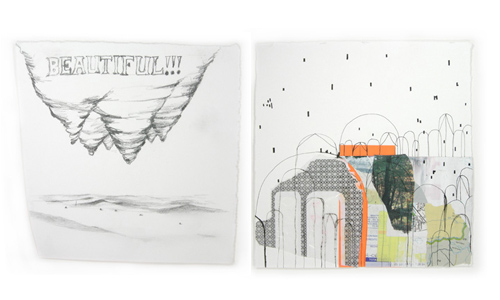
“I began building on a piece of land” is a series of 65 drawings and collages produced by Christine Kesler as she traveled from Brooklyn, NY to her new home in San Francisco, CA.

.
Christine Kesler is an artist who just made the move from Brooklyn, NY to San Francisco, CA where she is pursuing her MFA at CCA.
.
Christine Kesler’s Statement
In this age of immediacy and often-overwhelming wealth of information, the process of combining media is my driver for new discoveries and associations. My work is an investigative process of collecting languages, both visual and written, and finding new ways to map experiences. I gravitate towards items and images with palpable personal associations, such as my own photographs and found printed papers and handwritten notes. The photos document a specific place in time, found handwriting is a symbol for the conversations and secrets of strangers. This work means to explore the nature of material, converting literal objects into a new means of mark-making.
Sourcing found papers and my own drawings and photos, a somewhat cryptic environment emerges, layered with visual representations of various lands and languages, giving evidence of distances traveled by combining raw materials found in the streets of Central America, Europe, and North America. Each work calls into question the process of making art and taking directly from ones surroundings. The viewer is invited into these spaces to find their own relationships between the abstract and the literal, the foreign and the familiar.
LINKS
Archives
Lego Hello World
I wish all my printers were made of legos.
LIFE photo archive hosted by Google
Images from Life Magazine going back to 1860′s, hosted by Google
Coming Face To Face With The President
Well crafted story about an under-heard point of view.
In California, Pot Is Now an Art Patron
A new funding source for the arts – reaping big rewards and funding many projects. It’s pot.
Notes on Portraiture in the Facebook Age
Celebrity Book Club: A List to End All Lists
Because, well, it’s sortof awesome.
Are "Artists' Statements" Really Necessary?
The pros and cons about that nemesis for most artists.
This to That
You tell it what you’ve got and it’ll tell you what to glue them together with.
Work of art: Online store for buyers, sellers
Not the TV show! Kelly Lynn Jones from Little Paper Planes is interviewed on her project, gives us a cheat sheet to local affordable art resources.









